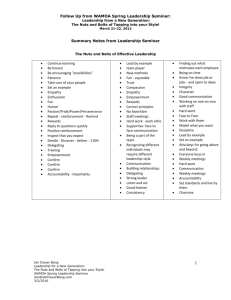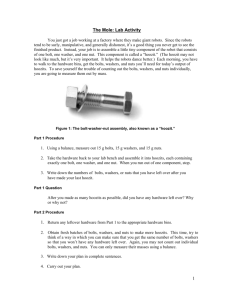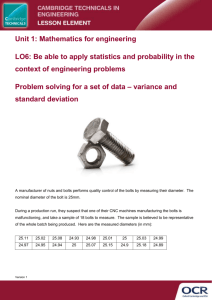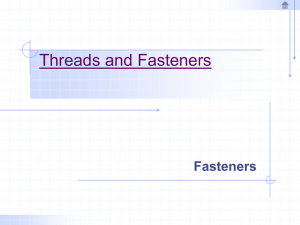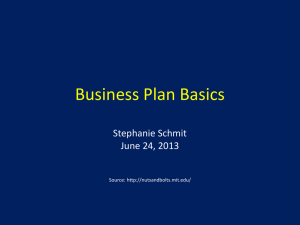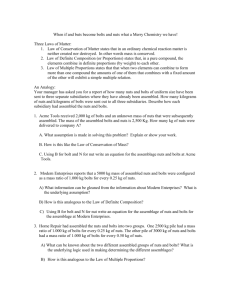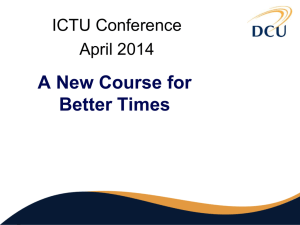The Nuts and Bolts of Business Plans
advertisement
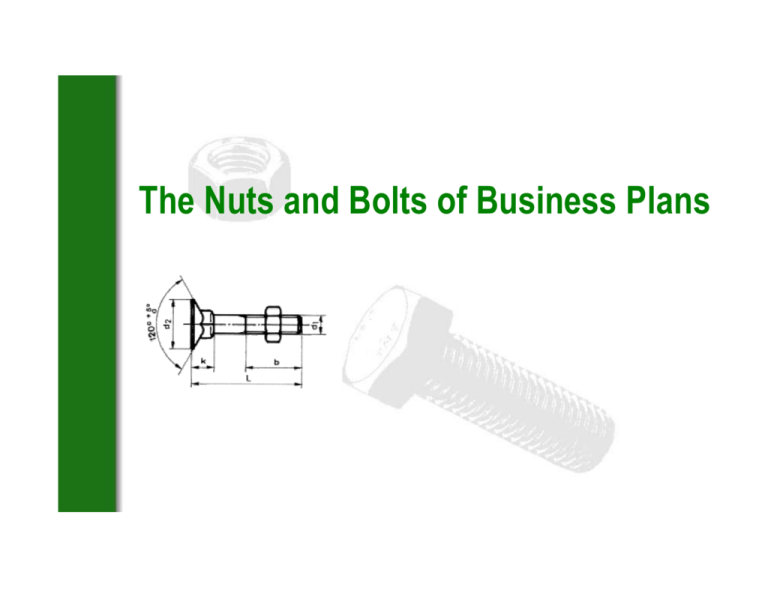
The Nuts and Bolts of Business Plans A Brief Introduction to Virtual Ink The Nuts and Bolts of Business Plans SESSION 1: BUSINESS PLAN BASICS • The Business Plan - A SUPPORTED VISION Mission Statement 1 paragraph Elevator Speech 30 seconds Executive Summary 2-5 pages PowerPoint Presentation 10-15 minutes Full Business Plan The Nuts and Bolts of Business Plans Team Sales and Distribution Competitive Analysis Market Analysis Intellectual Property Technology Financial Projections 20-30 pages Detailed Support/Foundation SESSION 1: BUSINESS PLAN BASICS What We Will Discuss Today: – Why Write A Business Plan? – What Should Be In A Business Plan? – The Business Plan As A Financing Document The Nuts and Bolts of Business Plans SESSION 1: BUSINESS PLAN BASICS Why Write a Business Plan? – Because I have to... – – – – Needed for financing Strategic partnering To explain business to customers/suppliers To attract key people The Nuts and Bolts of Business Plans SESSION 1: BUSINESS PLAN BASICS Why Write a Business Plan? – Because I Need to Understand My Business • The Business Plan is a result of a PLANNING PROCESS Who are your customers? Why will the buy your service or product? What will they pay? How will you make and deliver the service/product What resources (people, money, technology) will you need? – Can you make money/create value? – – – – – The Nuts and Bolts of Business Plans SESSION 1: BUSINESS PLAN BASICS • Types of Plans • Operational plans • External plans – Summary Plan – Full Business Plan • Who should write the Plan? • CEO alone? • The team? • A hired writer/consultant? The Nuts and Bolts of Business Plans Business Plan Targeting Audience Issues to Emphasize Issues to De-emphasize Length Investor Fast growth, potential large market, management team Assets 20 – 40 pages Strategic Partner Synergy, proprietary products Sales force, assets 20 – 40 pages Banker Cash flow, assets, solid growth Fast growth, hot market 10 – 20 pages Large customer Stability, service Fast growth, hot market 20 – 40 pages Key employees Security, opportunity Technology 20 – 40 pages Merger & acquisition Past accomplishments Future outlook 20 – 40 pages Excerpted from: Gumpert, David E., How to Really Create A Successful Business Plan, INC Publishing 1990 The Nuts and Bolts of Business Plans SESSION 1: BUSINESS PLAN BASICS • What Should Be In A Business Plan? • Size/Packaging Of The Plan • Avoid the 3" thick binder • Separate binding of Executive Summary? • How to bind? – – – – staple spiral Velabind Accubinder • Appearance should be professional but not overly slick The Nuts and Bolts of Business Plans SESSION 1: BUSINESS PLAN BASICS • What Should Be In A Business Plan? – The Plan is a SELLING DOCUMENT – Don't lose sight of the vision – The excitement must come through – The Plan should project your image – BUT: The Plan Must Be Defensible The Nuts and Bolts of Business Plans SESSION 1: BUSINESS PLAN BASICS • What Should Be In A Business Plan? – Elements of a Plan – – – – – – – – – – – – Executive Summary The Opportunity and the Company and its Services/Products Market Research/Analysis Economics of the Business Marketing Plan Design and Development Plan Manufacturing and Operations Plan Management Team Schedule Critical Risks, Problems and Assumptions The Financial Plan Appendices Notice That “Technology” Is NOT A Section The Nuts and Bolts of Business Plans SESSION 1: BUSINESS PLAN BASICS • What Should Be In A Business Plan? – Cover Page • • • • • • Name of Company Address Telephone/fax/email Confidentiality legend Securities law legend Control numbering of copies The Nuts and Bolts of Business Plans SESSION 1: BUSINESS PLAN BASICS CONFIDENTIAL This Business Plan has been prepared by Virtual Ink, a Delaware Corporation. It is being delivered, subject to prior execution of a Confidential Disclosure Agreement, to a limited number of parties who may be interested in investing in Virtual Ink Corporation. The sole purpose of this Business Plan is to assist the recipient in deciding whether to proceed with a further investigation of Virtual Ink, Corporation. While Virtual Ink Corporation believes that the financial and other information contained herein is accurate, Virtual Ink Corporation expressly disclaims any and all liability for express or implied representations or warranties contained in, or for omission from, this Business Plan, or any other written or oral representations and warranties which may be made to the investor in a Stock Purchase Agreement when, as and if one is executed, and subject to such limitations and restrictions as may be specified in such Stock Purchase Agreement, shall have any legal effect. This Business Plan shall not be photocopied, reproduced or distributed to others at any time without prior consent of Virtual Ink Corporation. It has been prepared for informational purposed related to this investment opportunity only and upon the express understanding that it will be used only for the purposes set forth above. Upon request, thisBolts recipientof willBusiness The Nuts and promptly return all material received from Virtual Ink Corporation (including this Business Plan) without retaining any copies thereof. In furnishing this Business Plan, Virtual Ink Corporation undertakes no obligation to provide the recipient with access to any additional Plans SESSION 1: BUSINESS PLAN BASICS • What Should Be In A Business Plan? – Table of Contents • Put one in • Include page numbers The Nuts and Bolts of Business Plans SESSION 1: BUSINESS PLAN BASICS The Nuts and Bolts of Business Plans SESSION 1: BUSINESS PLAN BASICS • What Should Be In A Business Plan? – Executive Summary • An Executive Summary is – – – – NOT an abstract of the plan NOT an introduction NOT a preface NOT a random collection of highlights • An Executive Summary IS the Business Plan in miniature The Nuts and Bolts of Business Plans SESSION 1: BUSINESS PLAN BASICS • What Should Be In A Business Plan? -Executive Summary (continued) • Size – Two pages (preferable) to five pages (max) • The Executive Summary must be – Logical – Clear – Interesting/Exciting • The Executive Summary is like a RESUME – If it gets the reader’s attention, the rest gets read – The Elevator Speech is to the Exec Summary as the Exec Summary is to the Full Plan The Nuts and Bolts of Business Plans SESSION 1: BUSINESS PLAN BASICS • What Should Be In A Business Plan? -Executive Summary (continued) • The Executive Summary tells Who you are What your strategy/vision is What you are doing and/or propose to do What is the market How many $$$$ do you need and what will you do with them – What your SUSTAINABLE COMPETITIVE ADVANTAGE is • When the reader is finished he or she should be able to tell someone what you are up to. – – – – – The Nuts and Bolts of Business Plans SESSION 1: BUSINESS PLAN BASICS • What Should Be In A Business Plan? -Executive Summary (continued) • The Executive Summary Should Contain: – – – – – – Description of the Business Concept and the Business The Opportunity and Strategy The Target Market and Projections The Competitive Advantages The Economics, Profitability and Harvest Potential The Team The Nuts and Bolts of Business Plans EXECUTIVE SUMMARY: ELECTRONIC COMPONENTS, INC. EXECUTIVE SUMMARY: PEOPLE EXPRESS The Eastern seaboard of the United States is ripe for the entry of a new, superefficient, low-cost air carrier to provide quick, reliable inter-city air transportation. Such an entity would bring to the Northeast the same benefits that have accrued to other areas of the United States. Chief among these are: ?? Frequent jet commuter service between major cities ?? Prices competitive with private automobiles ?? Fulfillment of the congressional goals in enacting the Airline Deregulation Act of 1978 to have better service at lower fares. The new company will be able to achieve these goals for the following reasons: ?? Aggressive, innovative management that has been tested in the field and been on the leading edge of innovation in air transportation marketing and systems ?? Equipment and facilities designed specifically for the low-cost production of air transportation ?? Manpower selected, trained, and motivated to be efficient and profit oriented ?? New systems to be applied to the entire business of air transportation to minimize investment in manpower and machines All of these, when applied to the new entity, will result in considerable economies vis-à-vis existing air carriers. ?? 40 years of regulation have created an industry heavily unionized with tremendous inefficiencies ?? The economics of a new entity should be at least 30%-40% better per seat mile than the current trunks. ?? Other new carriers such as Southwest or Air Florida have shown a consistent ability to compete on a price basis and earn extraordinary returns ?? The current political, economic, and regulatory climate is ideal for the proposal herein envisioned. ?? The Northeast is waiting for someone to bring it what the rest of the nation already has: low air fares. Excerpted from: Gumpert, David E., How to Really Create A Successful Business Plan, INC Publishing, 1990 Electronic Components, Inc. is a start up company that will make a variety of electronic components, beginning with a new type of aluminum-based capacitor. This unique product, coupled with excessive demand for capacitor devices, will provide us with an ample share of the capacitor market and numerous opportunities for expansion into related electronic components. The founders are dedicated and determined to make the venture a successful and profitable entity. Technical expertise is provided by James F. Lynch, who has been involved in designing capacitors for 11 years. He obtained a Bachelor of Science degree in electronic engineering from the Massachusetts Institute of Technology. Technology for capacitors is changing rapidly. Electronic Components, Inc. has an opportunity to capitalize on a major technological change by getting off to a quick start and expanding quickly. This proposal pertains to two additional phases of required financing. The first phase, consisting of about $150,000 for pilot plant start-up, has been completed from the personal funds of the principals. The remaining financing is for the following: Phase Two: Obtain $750,000 capital for: ?? Hiring and training production personnel; ?? Purchasing additional equipment productivity; ?? Develop the market; ?? Complete the sales rep network; necessary for appropriate ?? Explore new markets. Phase Three: Increase Production and Sales ?? Computerize manufacturing to triple output with minimal increase in labor; ?? Begin exporting; ?? Expand new marketing activity. Financing will be used to purchase manufacturing equipment, hire the necessary employees, and develop new markets. In addition, management intends to spend between 10% and 20% of revenues on research and development of new products. The electronic component field offers attractive opportunities for fast sales and profit growth. Already, demand exceeds supply in the capacitor area as well in other related areas. The Virtual Ink Executive Summary Virtual Ink Corporation is a computer peripherals company whose lead product automatically transcribes what users write on existing chalk or whiteboards, thus enabling automatic, inexpensive, error-free, real-time transcription of handwriting and sketching . Virtual Ink was the first place runner-up in the 1997 MIT Entrepreneurship and Business Plan Competition for its primary product, the e•pen ™ . e•pen ™ is a labor -saving, productivity and communication enhancement tool that could enable the automatic capture of valuable shared thoughts communicated daily between millions of office and academic users. EXECUTIVE SUMMARY *What is the product ? e•pen ™ is a patentable human-computer interface tool that converts any common writing surface as large as 10 meters x 16 meters into an electronic transcription device. e•pen ™links the writing instrument wirelessly to a personal computer replacing the need for subsequent manual transcription. Hand sketches and notes can be captured accurately, rapidly, and automatically during brainstorming sessions and incorporated directly into documents. *What is the market size ? The estimated 50 million white-collar offices world-wide with both a personal computer and either a chalk or whiteboard are potential e•pen ™sales candidates. We anticipate initial adoption by several hundred thousand team-oriented professionals such as management consultants, design engineers, academics, and industrial designers. Over time, the direct electronic capture of written group meeting notes will be as indispensable as a common conference call or document photocopying. *What are the startup costs ? Virtual Ink anticipates initially requiring $320,000 to complete the beta prototype of the e•pen™, provide for legal and infrastructu re expenses related to startup and to cultivate potential customers. To finance start -up we intend to seek initial capital from venture capitalists and corporate partners. Further investment of $2.0 million is needed for finalizing the product, further setting up company infrastructure, lining up lead vendor-channel relationships, landing significant corporate accounts, and accelerating global marketing efforts. *What is the payoff ? Virtual Ink anticipates break-even within 2 years. In addition to our product sales, we expect royalty revenue from licensing our position sensing and software technology. Within 3 to 5 years, Virtual Ink anticipates an IPO or sale of the company to fuel further growth and to offer liquidity to investors. * Management Team The technology component of the management team consists of MIT-trained engineers: Yonald Chery (product conceiver and Chief Technology Officer), William Moyne (Software Development Lead), Andrew Kelley (Manufacturing Development Lead), and Matthew Verminski (Hardware Development Lead). The business component of the management team currently consists of MIT Sloan-trained finance and marketing members: Michael Dixon (Chief Financial Officer) and Rosaline Gulati (Marketing Director). We are currently recruiting a chief executive officer and directors for our corporate board. SESSION 1: BUSINESS PLAN BASICS • What Should Be In A Business Plan? – The Body of the Plan• The Opportunity – What is the Market / Opportunity? » How big is it now? » What are the trends- how fast is it or will it grow? – Why Is This Time The Right Time For Your Product/Service? » Convergence of Opportunity and Solution The Nuts and Bolts of Business Plans SESSION 1: BUSINESS PLAN BASICS • What Should Be In A Business Plan? -The Body of the Plan • Market Analysis – Existing and planned products in marketplace – Market segments – Market players/competition » Competitive Advantages – Estimated Market Shares » Current Players » You The Nuts and Bolts of Business Plans SESSION 1: BUSINESS PLAN BASICS • What Should Be In A Business Plan? -The Body of the Plan – Economics of Business – What Are Your: » Expected Gross and Operating Margins » Profit potential and erosion » Fixed, variable and semivariable costs » Months to breakeven » Months to Cash Flow Positive The Nuts and Bolts of Business Plans SESSION 1: BUSINESS PLAN BASICS • What Should Be In A Business Plan? -The Body of the Plan • Marketing Plan – What is your Marketing Strategy? – Pricing and Distribution » Pricing and margin erosion » Distribution must match strategy/pricing – Sales Tactics » Who will be the first customer, second customer etc.? » How will you reach the customer? – Advertising and Promotion The Nuts and Bolts of Business Plans SESSION 1: BUSINESS PLAN BASICS • What Should Be In A Business Plan? -The Body of the Plan • Development Plan – Where is development today- product status – What development is needed? » Time and resources needed for development » Do you have to produce a complete product to get going? Avoid “Nuclear Fusion” – Difficulty and Risks – Product Pipeline Plans The Nuts and Bolts of Business Plans SESSION 1: BUSINESS PLAN BASICS • What Should Be In A Business Plan? -The Body of the Plan • The Development Plan (cont) • Intellectual Property » Do you have patents? » How broad is your intellectual property protection? » How do you compare to your competitors? » Other technologies? – Proprietary Rights » Do prior employers have rights? The Nuts and Bolts of Business Plans SESSION 1: BUSINESS PLAN BASICS • What Should Be In A Business Plan? -The Body of the Plan • Manufacturing and Operations Plan Operating Cycle Geographical Location Facilities needed Strategy and Plans » outsourcing vs. in-house – Regulatory and Legal issues » FDA » Environmental – – – – The Nuts and Bolts of Business Plans SESSION 1: BUSINESS PLAN BASICS • What Should Be In A Business Plan? -The Body of the Plan • The Team – The Internal Team » Background of principals » How long has the company been in operation? – The External Team » Board of Directors » Advisory Board » Professional Advisors » Don’t “name drop” if the external person has not agreed to be mentioned The Nuts and Bolts of Business Plans SESSION 1: BUSINESS PLAN BASICS • What Should Be In A Business Plan? -The Body of the Plan • Action Plan – What Will You Do and When? » Identification of “Credibility Testers” » Sequencing to build VALUE » Eliminate or Reduce Dependencies » Coordination of Schedule, Value Recognition Events and Financing Requirements The Nuts and Bolts of Business Plans SESSION 1: BUSINESS PLAN BASICS • What Should Be In A Business Plan? -The Body of the Plan • Risk Factors and Critical Assumptions – Be sure to address Negatives as well as Positives » There are always negatives/problems – Set the stage for the reader – Show that you have a plan for getting around or minimizing the negatives – Reduce Dependencies If Possible The Nuts and Bolts of Business Plans SESSION 1: BUSINESS PLAN BASICS • What Should Be In A Business Plan? -The Body of the Plan • The Financial Plan – Actual Income Statements and Balance Sheets – Pro Forma » Income Statements » Balance Sheets » Cash Flow Statements » Breakeven Chart – Assumptions should be stated » Get these right or defensible The Nuts and Bolts of Business Plans SESSION 1: BUSINESS PLAN BASICS • What Should Be In A Business Plan? -The Body of the Plan The Financial Plan (cont.) Spreadsheetitis Do numbers balance? Do the numbers tie to the PLAN CASH IS KING – C I M I T Y M Use traditional financial statement presentation – Now is NOT the time to invent new methods of presentation » Get help if you aren't expert – Tie to rounds of financing/expansion – – – – – The Nuts and Bolts of Business Plans SESSION 1: BUSINESS PLAN BASICS • What Should Be In A Business Plan? – Appendices – – – – – – – – – Separately Bound Volume Resumes of Principals Product Literature Trade Press/Business Press Patents (front page) Testimonials Letters Technical Information Confidentiality Technical person to technical person discussion The Nuts and Bolts of Business Plans SESSION 1: BUSINESS PLAN BASICS • Fine Tuning/Targeting the Plan • Have an Independent Reader Review the Plan – One or more independent readers for feedback: » Retired industry pro? » Customer(?) » Consultant? » Professor? » Accountant- yes definitely » Lawyer- yes definitely The Nuts and Bolts of Business Plans SESSION 1: BUSINESS PLAN BASICS The Business Plan As A Financing Document (Excerpts From Materials Prepared By Lita Nelsen, Director of MIT Technology Licensing Office) • A. First Reading: Like a Resume – Make The Cut, So That You Get An Opportunity To Tell Your Story • B. Second Reading: Justify The Investment • C. Third Reading: Commit To A Plan – That You And The Investors Can Live With. • REMEMBER: If you don’t make the FIRST CUT, B and C never happen. The Nuts and Bolts of Business Plans SESSION 1: BUSINESS PLAN BASICS The Business Plan As A Financing Document – MAKING THE FIRST CUT An Idea Too Good To Ignore A Financial Promise Too Good To Turn Down A Team Good Enough To Believe In An Action Plan That’s » Credible » Focused – Details That Give Assurance of Insight, Commitment and Follow Through – Format and Style That Show » Passion » Sanity – – – – The Nuts and Bolts of Business Plans SESSION 1: BUSINESS PLAN BASICS The Business Plan As A Financing Document • . WHY PLANS FAIL THE FIRST CUT – Insufficient Market – Non-Credible Technology » Too Wild » Too Blue-Sky (Unproven) » Not Protectible » Too Mundane – Investment Too Large For The Promise – Failure to Understand The Market The Nuts and Bolts of Business Plans SESSION 1: BUSINESS PLAN BASICS The Business Plan As A Financing Document • . WHY PLANS FAIL THE FIRST CUT (cont.) – Action Plan Not Credible » Too Optimistic » Naïve About The Hurdles » Runs Off In All Directions » Not Ambitious Enough » Regulatory Barriers Insufficiently Addressed » Gaps Filled By Handwaving » No Promises At All – Team Not Credible The Nuts and Bolts of Business Plans SESSION 1: BUSINESS PLAN BASICS The Business Plan As A Financing Document • COSMETIC” REASONS FOR FAILING THE FIRST CUT – I Can’t Understand It. – Filled With Market Or Technology-Specific Jargon » i.e., WHAT IS THE BUSINESS? – Naïve Projections – Sloppy: Misspellings, Poor Grammar, Poor Quality Printing – Too Damn Long – Ignores The Basics – “Forget Marketing, My Technology Is Best” – Naïve (or Terrible) Writing The Nuts and Bolts of Business Plans SESSION 1: BUSINESS PLAN BASICS • SUMMARY – We Have Covered • Why Write A Business Plan? • What Should Be In A Business Plan? • The Business Plan As A Financing Document The Nuts and Bolts of Business Plans SESSION 1: BUSINESS PLAN BASICS • The Business Plan - A SUPPORTED VISION Mission Statement 1 paragraph Elevator Speech 30 seconds Executive Summary 2-5 pages PowerPoint Presentation 10-15 minutes Full Business Plan The Nuts and Bolts of Business Plans Team Sales and Distribution Competitive Analysis Market Analysis Intellectual Property Technology Financial Projections 20-30 pages Detailed Support/Foundation
